A Leap into the Unknown


Continuous Evolution in Pursuit of the Ideal Instrument
Introduced here is the story behind Shimadzu’s first-ever Dimensional X-ray CT system enabling 3-dimensional measurements. The X-ray CT team has taken a leap into unknown areas, in response to customers' needs.
Can't This Be Used for Measurement?
As the name suggests, non-destructive inspection instruments inspect objects without destroying them. Using X-rays that can see through objects, an image can be obtained of the interior state, which can then be analyzed or inspected.
Non-destructive inspection instruments play an essential and important role in product development and quality management. Shimadzu Corporation produced the first medical X-ray device in Japan. Shimadzu's non-destructive inspection instruments apply these technologies, and have earned a reputation for high image quality and reliability.
Around 2008 a major change occurred in one of the non-destructive inspection instruments, an X-ray CT system that could obtain 3D images. This was due to the arrival of high-performance computing (HPC) using GPUs. A GPU is a computing processor for image processing. Using HPC makes it possible to carry out processing other than image processing. Constructing the processing system with a HPC at the heart dramatically reduced the time required from scanning until display of the image.
"When I joined the company, one or two hours were required to produce 3-dimensional data. In only three years, the time to produce an image dropped to 10 to 20 seconds. It really feels like the data is being produced simultaneously with image taking," Project Leader Mr. Keyaki reflected.
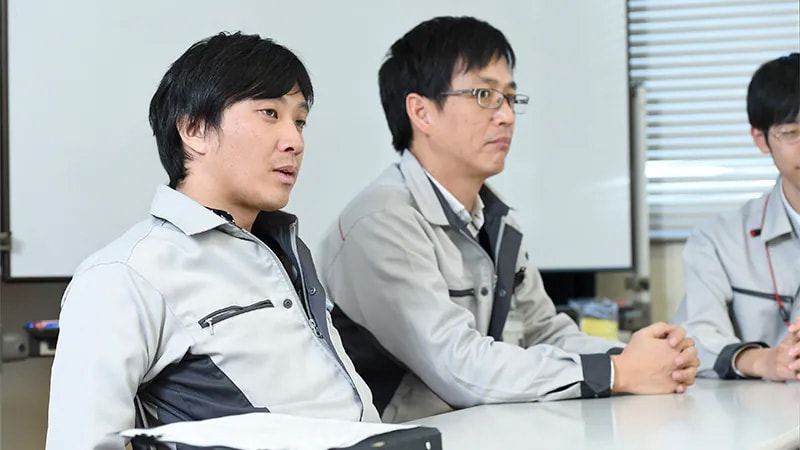
This transformation in technology was warmly welcomed by customers. At the same time, a new voice was heard by the development team.
"Isn't it possible to measure dimensions with this?"
The question asked by the customer refers to the technology for 3-dimensional measurement. A typical measurement method is to move a highly accurate sphere, referred to as a probe, in order to trace the surface of a sample that is the object of the measurement, thereby collecting numerous data points to produce 3-dimensional coordinate information. Precise dimensions in micron units can be obtained. Such a technique is essential in development work, during which prototypes are measured to check whether they have been produced in accordance with the design, the coordinate information obtained is fed back into the CAD software used in the design, etc..
X-ray CT, a specialty of Shimadzu, is similar in that it also obtains 3-dimensional coordinate information in order to produce 3-dimensional images. Moreover, unseen internal dimensions can also be seen by X-ray visualization, greatly increasing the range of applications. In addition, with conventional 3-dimensional coordinate-measuring machines, it often requires several hours to measure a sample such as a small cup, but with X-ray CT, the measurement time is only about 1 hour. It was only natural that customers would want this.
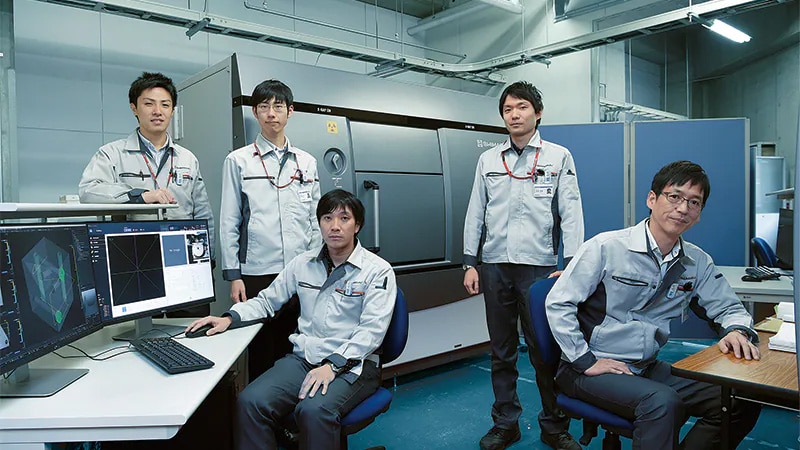
Members of the development team around the XDimensus 300. In the photograph from the left are: Daisuke Harada, Assistant Manager, Non-Destructive Inspection Business Unit, Analytical & Measuring Instruments Division; Makoto Sato, Assistant Manager, AI Solution Unit, Technology Research Laboratory; Yasuyuki Keyaki, Assistant Manager and Takuma Niizaka, Assistant Manager, Non-Destructive Inspection Business Unit, Analytical & Measuring Instruments Division; and Shuhei Onishi, Assistant Manager, Quality Assurance Department, Analytical & Measuring Instruments Division. This team of individuals came together from various backgrounds to achieve the ideal solution for users.
Start from Zero
However, 3-dimensional measurement was an unknown field for the Shimadzu development team. Therefore, they held meetings with the company’s Manufacturing Center, which uses 3-dimensional coordinate-measuring machines on a daily basis, and rapidly absorbed their knowledge and technology. What they came to understand was the need for absolute precision.
In order to obtain accurate measurement values, the instrument itself must be accurate. When the sample to be measured is placed on the platform, the positional relationship and angle between the X-ray source and the detector that receives the x-rays must be the same, no matter how many times it is measured. Precise calibration is required to accurately correct for the unavoidable errors that occur in installation. Special tools are required for this purpose.
"With X-ray CT, each part must have the accuracy required in order to produce clear images. However, the accuracy required in this case is higher than normal by an order of a magnitude or two. The calibration procedures and methods had to be completely reviewed, and sturdy hardware was required," reflected Mr. Onishi, who was the leader from the start of the development.
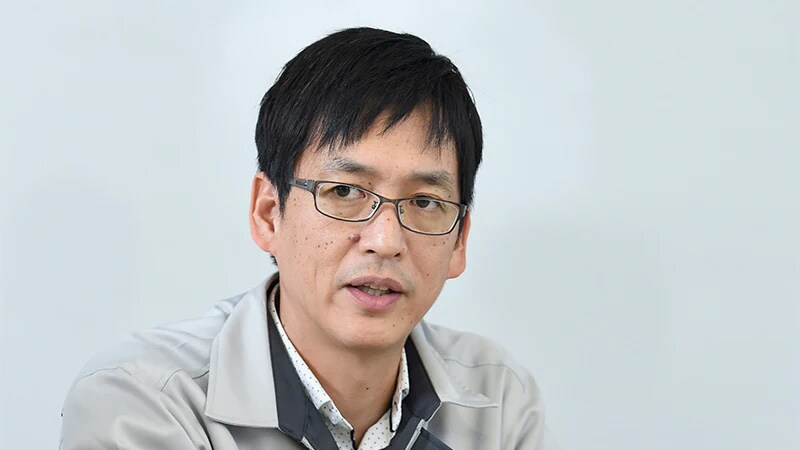
Mr. Harada says he will never forget the conversations he had with suppliers of parts for precision instruments.
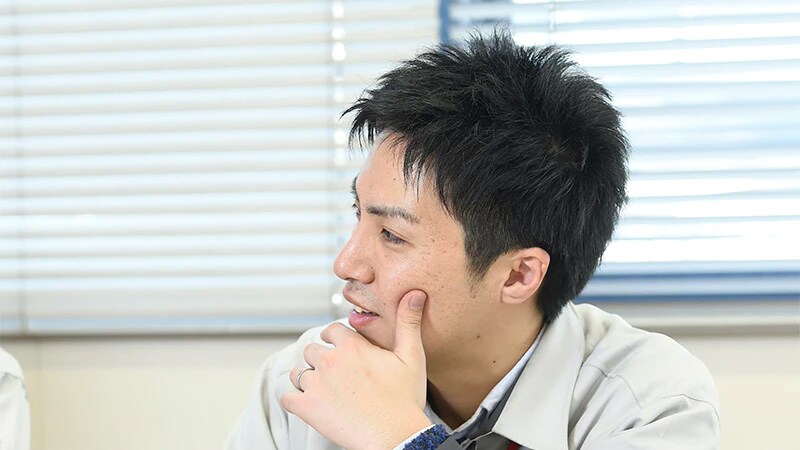
"They spoke about rock, saying 'Rock from South Africa is good,' or 'Indian rock is what you should use,' and so on. At first I did not know what they were talking about."
An important component for CT imaging is the base, a platform made of rock, for the X-ray generator, X-ray detector, stage, etc. If the temperature rises and the base expands, then the accuracy required from the measuring instrument cannot be obtained. Therefore, selecting the right stone was essential.
The Battle with Errors
Mr. Niizaka used Shimadzu X-ray CT for research of CAD models and modeling in his student days.
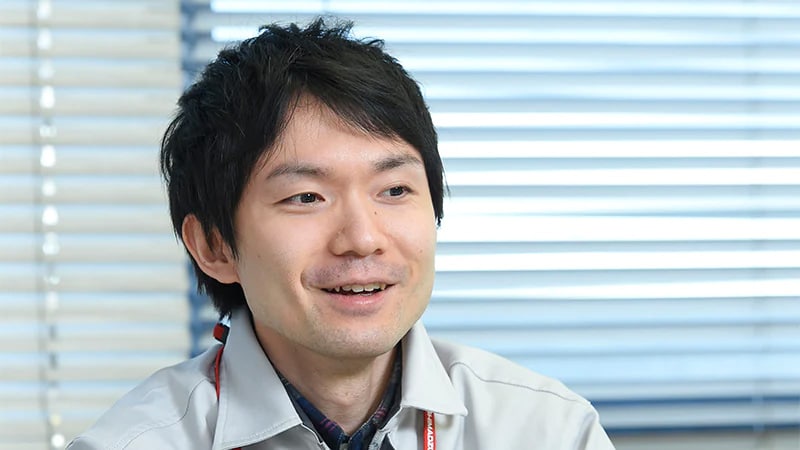
"When I joined the company I was delighted to join the CT development section, but I was a bit puzzled when I was told that stone was important. Mechanical matters were totally outside my specialty, so I had to study thermal expansion."
Niizaka really showed his worth in the development of X-ray source correction technology.
"When x-rays are continuously produced, the X-ray generator becomes hot, and the point of generation deviates. When this happens, the magnification factor also deviates and the dimensions get distorted. In order to stabilize the point of generation, a program was produced so that the position of the X-ray focal point gets detected in real time, and the amount of movement is taken into consideration when reconfiguring the data."
Dr. Sato, who had specialized in mathematics in his student days, produced a "system of errors."
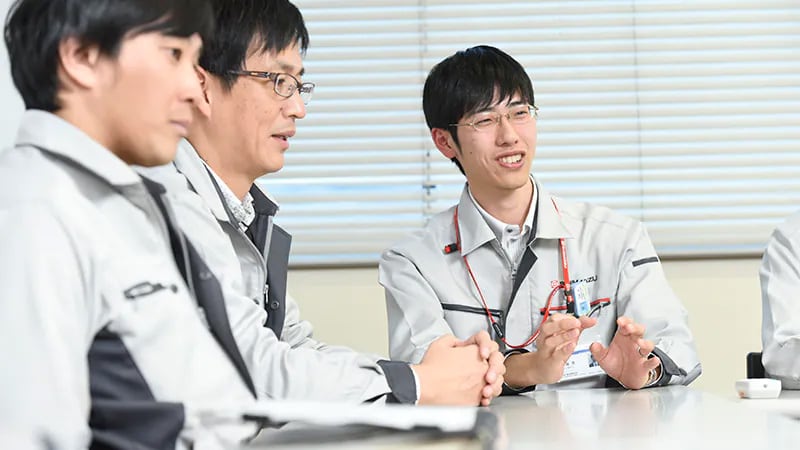
"I listed the errors that could occur if this part moved or that part moved. The more I looked into it, the more I found sources of errors. I do not remember how many tens of places there are from which errors could arise. One by one I thought of ways to eliminate the errors, such as changing the stone to a more stable one or reducing the temperature variations."
From this, Niizaka and members of Non-Destructive Inspection Business Unit figured out the allowable range of temperature variation to be 20 ±0.5 degrees. Accordingly, they worked with other departments to simulate the direction and flow rate of the air conditioning air fed into the instrument, and determined the position to maintain the temperature within the instrument uniform.
In addition, there were additional issues. In particular, problems they had not seen before with the prototype appeared from the calibration tool produced for commercialization, and every day they repeated tests on it. However, every member of the team performed their own role, and gradually the problem points were resolved. Finally, in December 2017, the XDimensus 300 Dimensional X-Ray CT System was released.
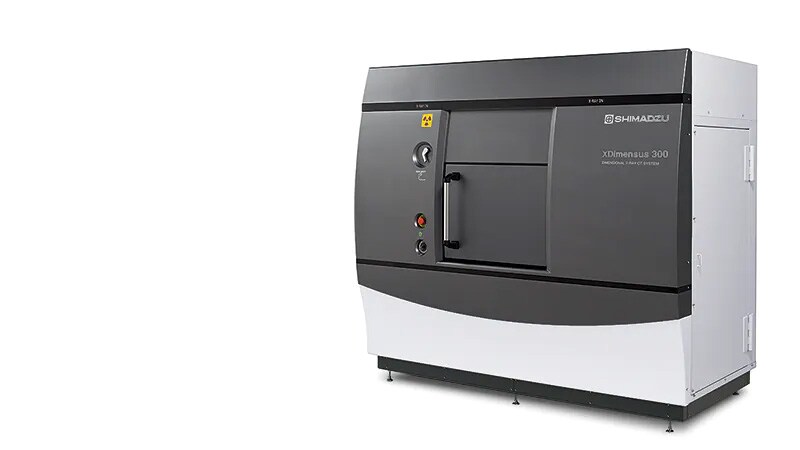
The XDimensus 300 Dimensional X-Ray CT System that Achieves the World's Highest Level of Measurement Accuracy and Observational Capacity
"Compared with previous products, the size is considerably smaller. Also, in contrast to other instruments, the room itself does not need to be maintained at a constant temperature. This unique feature has resulted in an increased number of inquiries." (Onishi)
There are still some issues remaining before achieving the ideal instrument. Development to overcome these issues is progressing. Evolution of the instrument and its developers does not stop.
* The information including affiliates and titles of the persons in this article are current as of the time of interviewing.
 Copied
Copied

